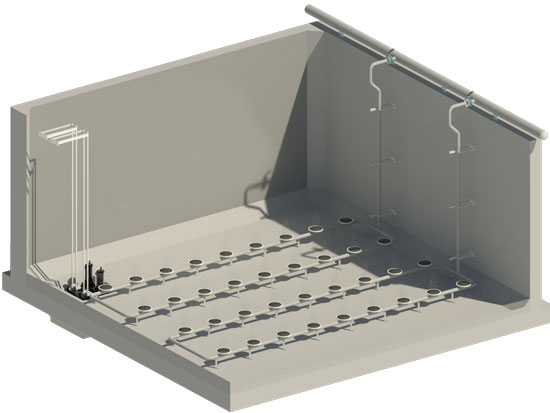The equalization tank plays an important role in the wastewater treatment process. Call now 0941.113.286 to get advice on the best products from ECLIM.
In wastewater treatment, if the flow or properties of the waste source continuously change, there is a method to help solve that problem, which is to use an equalization tank. So what is its structure, principle, and scope of application? Let our E&C company answer the above questions.
Main function: Used to regulate the flow and concentration of impurities in wastewater.

As mentioned above, for input wastewater sources with unstable flow rates and changing dirt concentrations, an equalization tank will be the best solution. This helps avoid the situation where the downstream treatment works are overloaded or have insufficient waste volume, helping the downstream treatment works work more stably and effectively.
Main structure
1. Tank part: The tank is usually made of reinforced concrete. However, there are also cases where the tank is built of soil, so the tank requires an additional layer of waterproofing sheet.
The tank volume is usually determined according to the flow chart and the fluctuation chart of dirt concentration in wastewater. With production wastewater, in case there is no water discharge chart, the tank volume can also be determined according to the flow rate of a production shift.
2. Anti-sedimentation system: The regulation tank is often placed behind the trash screen and sand sedimentation tank. However, it is unavoidable that wastewater still contains a lot of sand residue after settling. Therefore, this system helps prevent sand particles and sediment from settling at the bottom of the air conditioning tank. In addition, the amount of BOD and COD will also be more stable thanks to this mode, ensuring a reduction in load for downstream biological treatment works.
Anti-sediment aeration systems often use two basic types:
Operating principle of the air conditioner
The operating principle of the air conditioning tank is very simple. Normally, the equalization tank is located behind the trash screen and sand settling tank. Water after the sand settling tank will be transferred to the equalization tank and continue to the downstream treatment works according to the allowable flow. At the conditioning tank, the aeration system with anti-sediment function will be responsible for aeration with an air blowing speed of 10-15 liters of air/minute/m3. The air blowing discs will be distributed evenly on the bottom of the tank to avoid sedimentation in dead corners.
Scope of application of the conditioning tank:
The equalization tank is applicable to most types of capacity, however, if the flow rate is stable, it is not necessary to use an equalization tank.
Advantage:
Defect:

0 comments